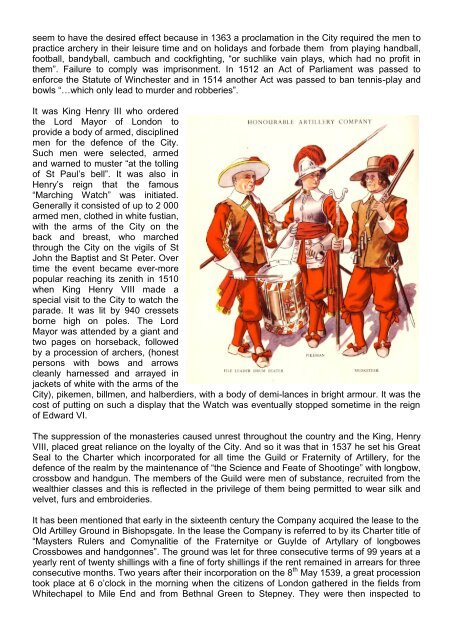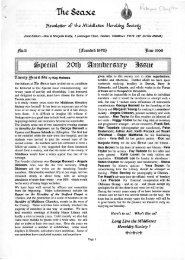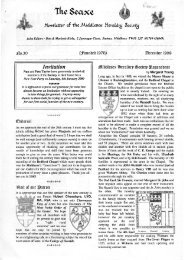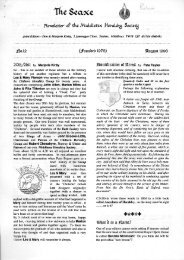No.57 - Middlesex Heraldry Society
No.57 - Middlesex Heraldry Society
No.57 - Middlesex Heraldry Society
Create successful ePaper yourself
Turn your PDF publications into a flip-book with our unique Google optimized e-Paper software.
seem to have the desired effect because in 1363 a proclamation in the City required the men to<br />
practice archery in their leisure time and on holidays and forbade them from playing handball,<br />
football, bandyball, cambuch and cockfighting, “or suchlike vain plays, which had no profit in<br />
them”. Failure to comply was imprisonment. In 1512 an Act of Parliament was passed to<br />
enforce the Statute of Winchester and in 1514 another Act was passed to ban tennis-play and<br />
bowls “…which only lead to murder and robberies”.<br />
It was King Henry III who ordered<br />
the Lord Mayor of London to<br />
provide a body of armed, disciplined<br />
men for the defence of the City.<br />
Such men were selected, armed<br />
and warned to muster “at the tolling<br />
of St Paul‟s bell”. It was also in<br />
Henry‟s reign that the famous<br />
“Marching Watch” was initiated.<br />
Generally it consisted of up to 2 000<br />
armed men, clothed in white fustian,<br />
with the arms of the City on the<br />
back and breast, who marched<br />
through the City on the vigils of St<br />
John the Baptist and St Peter. Over<br />
time the event became ever-more<br />
popular reaching its zenith in 1510<br />
when King Henry VIII made a<br />
special visit to the City to watch the<br />
parade. It was lit by 940 cressets<br />
borne high on poles. The Lord<br />
Mayor was attended by a giant and<br />
two pages on horseback, followed<br />
by a procession of archers, (honest<br />
persons with bows and arrows<br />
cleanly harnessed and arrayed in<br />
jackets of white with the arms of the<br />
City), pikemen, billmen, and halberdiers, with a body of demi-lances in bright armour. It was the<br />
cost of putting on such a display that the Watch was eventually stopped sometime in the reign<br />
of Edward VI.<br />
The suppression of the monasteries caused unrest throughout the country and the King, Henry<br />
VIII, placed great reliance on the loyalty of the City. And so it was that in 1537 he set his Great<br />
Seal to the Charter which incorporated for all time the Guild or Fraternity of Artillery, for the<br />
defence of the realm by the maintenance of “the Science and Feate of Shootinge” with longbow,<br />
crossbow and handgun. The members of the Guild were men of substance, recruited from the<br />
wealthier classes and this is reflected in the privilege of them being permitted to wear silk and<br />
velvet, furs and embroideries.<br />
It has been mentioned that early in the sixteenth century the Company acquired the lease to the<br />
Old Artilley Ground in Bishopsgate. In the lease the Company is referred to by its Charter title of<br />
“Maysters Rulers and Comynalitie of the Fraternitye or Guylde of Artyllary of longbowes<br />
Crossbowes and handgonnes”. The ground was let for three consecutive terms of 99 years at a<br />
yearly rent of twenty shillings with a fine of forty shillings if the rent remained in arrears for three<br />
consecutive months. Two years after their incorporation on the 8 th May 1539, a great procession<br />
took place at 6 o‟clock in the morning when the citizens of London gathered in the fields from<br />
Whitechapel to Mile End and from Bethnal Green to Stepney. They were then inspected to














